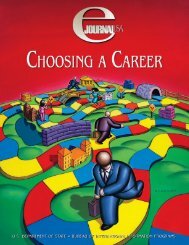Working for Women Worldwide - Embassy of the United States
Working for Women Worldwide - Embassy of the United States
Working for Women Worldwide - Embassy of the United States
You also want an ePaper? Increase the reach of your titles
YUMPU automatically turns print PDFs into web optimized ePapers that Google loves.
Education<br />
Americans recognize that education and training<br />
are <strong>the</strong> keys to a brighter future <strong>for</strong> any society, and <strong>the</strong><br />
Bush administration has made quality education one<br />
<strong>of</strong> its highest domestic priorities. First Lady Laura<br />
Bush, a <strong>for</strong>mer public school teacher and librarian, is<br />
among those who believe education is “our most urgent<br />
priority and should have <strong>the</strong> first and highest call on<br />
our time and resources.”<br />
The centerpiece <strong>of</strong> President Bush’s education<br />
initiatives is a landmark re<strong>for</strong>m known as <strong>the</strong> No<br />
Child Left Behind Act <strong>of</strong> 2001. Simply put, <strong>the</strong> No<br />
Child Left Behind initiative expects every child to succeed<br />
in learning, and it expects every school to provide<br />
<strong>the</strong> means <strong>for</strong> that success.<br />
Former Secretary <strong>of</strong> Education Rod Paige put it<br />
this way: “The No Child Left Behind Act is a more ...<br />
responsible approach to education. Like a successful<br />
business, <strong>the</strong> No Child Left Behind Act introduces<br />
measurement <strong>of</strong> progress, makes <strong>the</strong> system transparent<br />
and accountable, and introduces consumer choice.<br />
These ingredients ultimately make <strong>the</strong> system better<br />
and provide a better product.” Moreover, he noted,<br />
<strong>the</strong>re is already “considerable evidence that <strong>the</strong> law is<br />
working. While fourth-grade reading scores between<br />
1992 and 2000 remained stagnant, <strong>the</strong>re has been a<br />
five-point increase in <strong>the</strong> last three years nationally. ...<br />
The percentage <strong>of</strong> African-American and Hispanic<br />
fourth-graders who know <strong>the</strong>ir reading and math<br />
basics increased substantially more between 2000 and<br />
2003 than in <strong>the</strong> previous eight years combined. As a<br />
result, <strong>the</strong> achievement gap is closing.”<br />
Under <strong>the</strong> No Child Left Behind Act, <strong>the</strong> <strong>for</strong>mula<br />
<strong>for</strong> success is based on four key principles:<br />
demand accountability <strong>for</strong> results; emphasize what<br />
works, based on scientific research; expand parental<br />
options; and expand local control and flexibility.<br />
Such focus can only help improve <strong>the</strong> gains girls<br />
and women in <strong>the</strong> <strong>United</strong> <strong>States</strong> are already making.<br />
In many subject areas, girls have been closing <strong>the</strong><br />
achievement gap with <strong>the</strong>ir male counterparts or<br />
exceeding <strong>the</strong>m. Since 1982, <strong>for</strong> example, women have<br />
earned more than half <strong>of</strong> all bachelor degrees. They are<br />
enrolling more <strong>of</strong>ten in nontraditional fields such as<br />
architecture, engineering, and <strong>the</strong> sciences.<br />
Never<strong>the</strong>less, <strong>the</strong> Bush administration continues<br />
to undertake a number <strong>of</strong> education initiatives to provide<br />
greater opportunities <strong>for</strong> girls and women in <strong>the</strong><br />
<strong>United</strong> <strong>States</strong>. For example, an innovative program to<br />
encourage women in technology—Girls’ E-Mentoring<br />
in Science, Engineering, and Technology—provides<br />
mentoring, group support, and tutoring <strong>for</strong> girls aged<br />
13 to 18 by linking teenagers with pr<strong>of</strong>essional women<br />
in those technical pr<strong>of</strong>essions.<br />
The U.S. government also places an emphasis on<br />
early childhood education to ensure children are ready<br />
<strong>for</strong> school and ready to learn. “Head Start,” noted <strong>the</strong>n<br />
Secretary Paige, “is a critical component <strong>of</strong> our ef<strong>for</strong>ts<br />
to ensure that all children, regardless <strong>of</strong> <strong>the</strong>ir family<br />
background, enter school prepared to succeed.”<br />
Including 2005 funding, <strong>the</strong> Bush administration has<br />
requested $750 million in new funding <strong>for</strong> <strong>the</strong> Head<br />
Start pre-kindergarten program.<br />
The U.S. government understands that more can<br />
be done.<br />
Tommy Thompson, <strong>for</strong>mer secretary <strong>of</strong> <strong>the</strong><br />
Department <strong>of</strong> Health and Human Services (HHS),<br />
which administers <strong>the</strong> Head Start programs,<br />
explained it this way: “Data show that children served<br />
by this program indeed become more school-ready<br />
than <strong>the</strong>y would o<strong>the</strong>rwise be—but <strong>the</strong>y still lag far<br />
behind <strong>the</strong>ir more economically advantaged peers. We<br />
can protect <strong>the</strong> Head Start program that has served us<br />
well, and yet still aim higher, to serve Head Start children<br />
even better.” The U.S. government has instituted<br />
a National Reporting System to determine which<br />
Head Start centers are achieving <strong>the</strong>ir goals, and it has<br />
provided additional training <strong>for</strong> more than 50,000<br />
Head Start teachers.<br />
At <strong>the</strong> higher-education level, <strong>the</strong> <strong>United</strong> <strong>States</strong><br />
has expanded funding <strong>for</strong> Pell Grants by 47 percent, or<br />
nearly $4 billion, to help students pay <strong>for</strong> college. As<br />
funding rose, <strong>the</strong> number <strong>of</strong> Pell recipients has<br />
increased by nearly one million. These increased funds<br />
substantially help women, who constitute almost 64<br />
percent <strong>of</strong> Pell Grant recipients, compared with more<br />
than 56 percent <strong>of</strong> undergraduates overall in <strong>the</strong><br />
<strong>United</strong> <strong>States</strong>. Moreover, according to Secretary<br />
Paige, “Pell Grants are <strong>the</strong> most effective <strong>of</strong> <strong>the</strong> student<br />
aid programs in ensuring that low- and middleincome<br />
students have access to a college education.”<br />
Health<br />
American women are living longer, healthier lives<br />
than ever be<strong>for</strong>e; yet like women elsewhere in <strong>the</strong><br />
world, <strong>the</strong>y face difficult health challenges.<br />
Heart disease, <strong>for</strong> example, kills more women<br />
than all <strong>for</strong>ms <strong>of</strong> cancer combined. That’s why <strong>the</strong><br />
59












